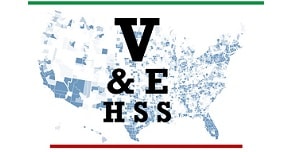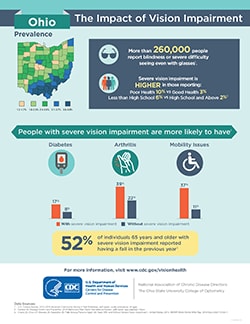Section 1: Tips for Collecting and Using Assessment Data
1. Explore Existing Surveillance Systems

Include data from the Vision and Eye Health Surveillance System when you assess the health needs of your community and create a community health improvement plan. This information will help you make vision and eye health a public health priority.
The federal government conducts several ongoing health-related surveys to collect vision and eye health information. For example, the Vision and Eye Health Surveillance System (VEHSS) collects data from national and state surveys, examination-based studies, electronic health records and registries, and administrative databases (e.g., Medicare, private medical insurance). This information helps health professionals, researchers, policymakers, and members of the public understand the scope of vision loss, eye disorders, and eye care services across the United States. The VEHSS was developed by CDC’s Vision Health Initiative and the non-partisan and objective research organization NORC at the University of Chicago. More information about the system’s data sources is available on the VEHSS website. The following are some of the national and state surveys included in the VEHSS:
- The American Community Survey (ACS) is an annual, nationally representative survey conducted by the US Census Bureau. It collects and produces information on demographic, social, economic, and housing characteristics of the US population.
- The Behavioral Risk Factor Surveillance System (BRFSS) is an annual health-related telephone survey conducted by CDC’s National Center for Chronic Disease Prevention and Health Promotion. It collects state-level data about US residents regarding their health-related risk behaviors, chronic health conditions, and preventive services use.
- The National Health Interview Survey (NHIS) is an annual household interview survey of the noninstitutionalized US population conducted by CDC’s National Center for Health Statistics (NCHS). It collects data on a broad range of health topics.
- The National Health and Nutrition Examination Survey (NHANES) is an annual self-report and examination survey conducted by CDC’s NCHS. It collects information on the health and nutritional status of US adults and children.
- The National Survey of Children’s Health (NSCH) is an annual survey conducted by the Health Resources and Services Administration’s Maternal and Child Health Bureau. It collects data on the physical and emotional health of US children from birth to age 17 years.
Many public health agencies use the BRFSS to monitor and assess the health status of the populations they serve. Since 2013, the BRFSS has included a core question about severe vision difficulty and blindness. During 2005–2011, the BRFSS also offered an optional 10-question module on vision and eye health. State-specific data from this module are on the VEHSS website. Both the BRFSS core vision question and the optional vision module have been tested to ensure that they provide data that can help public health agencies assess vision and eye health in their states. The core and optional BRFSS questions are provided in Appendix A of this toolkit.
2. Add Vision and Eye Health Assessment Questions to Other Health-Related Data Collection Activities
Several surveillance systems routinely collect data about other chronic conditions, such as diabetes, heart disease, and high blood pressure at federal, state, and local levels. Some of these systems could include key questions about vision and eye health. You can reach out to colleagues and potential partners who oversee these systems to look for opportunities to integrate vision and eye health assessment questions as appropriate.
3. Use Questions That Match the Overall Goals of Your Assessment
A vision and eye health assessment can be designed to collect a variety of data on a broad range of topics, or it can be designed to focus more narrowly on a specific topic, population, or condition. Although there is no single best way to structure your vision and eye health assessment, you should use assessment questions that are well-matched to the goals of your assessment.
- How many people have vision impairment (corrected or uncorrected)?
- What specific types of eye disorders (e.g., glaucoma, macular degeneration, cataract, diabetic retinopathy) do people have?
- What are the demographic characteristics (e.g., age, race, ethnicity, sex, education level, income level) of those with or at risk of vision impairment?
- Where are people with vision impairment or eye disorders geographically located in your community?
- What is the financial impact of visual impairment and eye disorders on your population?
- How many people have vision impairment or eye disorders and another chronic condition, such as diabetes, heart disease, or arthritis?
- How many people have vision impairment or eye disorders and other health-related conditions, such as balance problems, fall-related injuries, depression, social isolation, or cognitive decline?
- How many people are: Over the age of 40?
- Female?
- African American?
- Hispanic?
- Lower socioeconomic position?
- Without health insurance that covers eye and vision health?
- Engaging in health risk behaviors associated with vision impairment (e.g., smoking)?
- From a family with a history of eye disease (e.g., glaucoma)?
- Unaware of the risk factors for visual impairment and eye disorders?
- How many eye care providers are in your community? How are they distributed in rural versus urban areas?
- How many people who are at increased risk of vision impairment are using vision and eye care services?
- What types of interventions, strategies, and policies are already being used in your community to improve vision and eye health? How many people are using these interventions?
- What types of rehabilitation services for blindness or vision impairment are available in your community now? How many people who need these services are using them?
4. Translate and Share Your Assessment Data to Guide Public Health Action
Once you have analyzed the data, you should create a graphic representation of the information (i.e., data visualization). You can translate your data into charts, graphs, maps, or pictures. Choose the method that will best communicate your message to the audience you are trying to reach.
Once your data are ready to share, start with people in the community who helped you collect the data and those who could be affected by it. Set up group meetings or one-on-one appointments to share your results and get feedback before the data are released to the general public.
To the left is an example of how state-specific data about vision impairment can be presented in a 1-page fact sheet using graphics. Fact sheets are available for all US states on CDC’s State Profiles on Vision and Eye Health website. See From the Field for more information about how this fact sheet was developed.
- Community Health Assessment and Group Evaluation pdf icon[PDF – 5 MB] (CHANGE) is a data-collection tool developed by CDC’s National Center for Chronic Disease Prevention and Health Promotion.
- Community Needs Assessment: Participant Workbook pdf icon[PDF – 1 MB] is a document developed by CDC’s Division of Community Health.
- Appendix A. Behavioral Risk Factor Surveillance System Vision Health Questions
Assessing the status of vision and eye health is one of the first steps to determining how to monitor and improve vision and associated conditions in your community. Collecting and analyzing the most accurate and detailed data for your population will help you identify risk factors for vision impairment and improve accessibility to eye health services. This information will also help you determine the most appropriate partners to help you achieve your goals.
